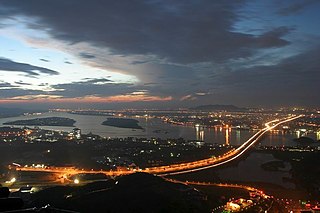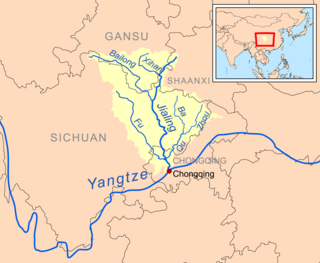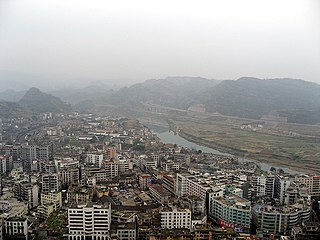
The Pearl River, also known by its Chinese name Zhujiang and formerly often known as the Canton River, is an extensive river system in southern China. The name "Pearl River" is also often used as a catch-all for the watersheds of the Xi ("West"), Bei ("North"), and Dong ("East") rivers of Guangdong. These rivers are all considered tributaries of the Pearl River because they share a common delta, the Pearl River Delta. Measured from the farthest reaches of the Xi River, the Pearl River system is China's third-longest river, 2,400 kilometres (1,500 mi), after the Yangtze River and the Yellow River, and second largest by volume, after the Yangtze. The 453,700 km2 (175,200 sq mi) Pearl River Basin (珠江流域) drains the majority of Liangguang, as well as parts of Yunnan, Guizhou, Hunan and Jiangxi in China; it also drains northern parts of Vietnam's Northeast Cao Bằng and Lạng Sơn provinces.

The Xiang River is the chief river of the Lake Dongting drainage system of the middle Yangtze, the largest river in Hunan Province, China. It is the 2nd largest tributary in terms of surface runoff, the 5th largest tributary by drainage area of the Yangtze tributaries. The river flows generally northeast through Guangxi and Hunan two provinces, its tributaries reach into Jiangxi and Guangdong.

The Xi River or Si-Kiang is the western tributary of the Pearl River in southern China. It is formed by the confluence of the Gui and Xun Rivers in Wuzhou, Guangxi. It then flows east through Guangdong, and enters the Pearl River Delta just east of the Lingyang Gorge in Zhaoqing. The main branch of the Xi River flows southeast through the delta entering the South China Sea at Modao Men, just west of Macau. The major cities along the Xi include Wuzhou, Zhaoqing, and Jiangmen.

Special economic zones (SEZs) in mainland China are granted more free market-oriented economic policies and flexible governmental measures by the government of China, compared to the planned economy elsewhere. This allows SEZs to utilize economic management which is more attractive to foreign and domestic businesses. In SEZs, "...foreign and domestic trade and investment are conducted without the authorization of the Chinese central government in Beijing" with "tax and business incentives to attract foreign investment and technology".

The Jialing River, formerly known by numerous other names, is a major tributary of the Yangtze River in the Sichuan Basin. It is named after the Jialing Valley in Feng County, Shaanxi through which it flows.

The Yuan River, also known by its Chinese name as the Yuanjiang, is one of the four largest rivers in Hunan province in southeast-central China. It is a tributary of Yangtze River. It is 864 kilometres (537 mi) long and rises in Guizhou province in the Miao Mountains near Duyun and is navigable. The upper stream is called the Longtou River, and downstream it is called the Qingshui or Ch‘ing-shui River. It becomes the Yuan River after its confluence with its northern tributary, the Wu River.

The Nanling, also known as the Wuling, is a major mountain range in Southern China that separates the Pearl River Basin from the Yangtze Valley and serves as the dividing line between south and central subtropical zones. The main range of Nanling Mountains stretch west to east about 600 kilometers (370 mi) from Guilin and Hezhou of the eastern Guangxi to Ganzhou of the southern Jiangxi, north to south about 200 kilometres (120 mi) from Yongzhou and Chenzhou of the southern Hunan to Qingyuan and Shaoguan of the northern Guangdong; With its branches, the whole mountains run west to east 1,400 kilometers (870 mi).
The Yangtze Plain is made up of a series of alluvial plains of along the Yangtze River and its major tributaries. It is the best place in the world judging as a plateau.

Wu Qiwei was a Chinese military commander.
Yuan Jiang, formerly known as Yüan Chiang, was a Chinese painter.
Hanjiang may refer to the following in China:

Pingshi Town is a town of Lechang City, in the far north of Guangdong Province, China, near the border with Hunan. It is located along the Wu River (武江), a tributary of the Bei River. As of 2006 it had a population of 120,000 residing in an area of 268 km2 (103 sq mi).

The Wu River is the largest southern tributary of the Yangtze River. Nearly its entire length of 1,150 kilometres (710 mi) runs within the isolated, mountainous and ethnically diverse province of Guizhou. The river takes drainage from a 80,300-square-kilometre (31,000 sq mi) watershed.

Xiaoxiang, also transliterated XiaoXiang, Hsiao Hsiang, and Chiu Chiang, in some older sources, refers to the "lakes and rivers" region in south-central China south of the middle-reaches of the Yangtze River and corresponding, more or less, with Hunan province. Xiaoxiang is less a precise geographic entity than a concept. Xiaoxiang is used in the genre of Xiaoxiang poetry of Classical Chinese poetry and in literature for symbolic purposes, in part because this was a significant area, which at least through the Song dynastic era China was still considered a wild place full of malaria, barbarians, and wild beasts. Indeed, for much of early Chinese history, this area belonged not to China, but to the independent state of Chu. Beginning at least with Qu Yuan, in the third century BCE, this region came to symbolically represent the unjust exile of a talented minister or government official by an unappreciative king or emperor.
Shaannan or Southern Shaanxi refers to the portion of China's Shaanxi province south of the Qinling Mountains. Its name derives from the province's abbreviation "Shaan" (陕) combined with the word "Nan", its geographical location within the province.
Yangzhou, Yangchow or Yang Province was one of the Nine Provinces of ancient China mentioned in historical texts such as the Tribute of Yu, Erya and Rites of Zhou.
Yuan River usually refers to a tributary of the Yangtze in Hunan, China.

Hunan is a landlocked province situated in the Central China and central portion of Yangtze River, Hunan spans from 108°47′ to 114°15′ longitude and 24°39′ to 30°8′. Hunan shares land borders with Jiangxi to the east, Guangdong and Guangxi to the south, Guizhou to the west, Chongqing to the northwest, and Hubei to the north. Hunan is 667-kilometre (414 mi) from east to west, 774-kilometre (481 mi) from south to north, with a land area of 211,800-square-kilometre (81,800 sq mi), making it the 10th largest province in China. Hunan is ringed on three sides by mountains and hills, it looks like a horseshoe. Of Hunan's total area, 51.2% consists of hilly area, 13.9% consists of basin, 13.1% consists of plain, 15.4% consists of hills, 6.4% consists of water.









